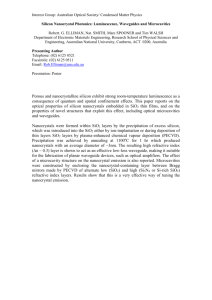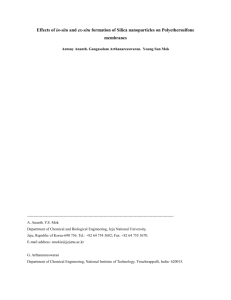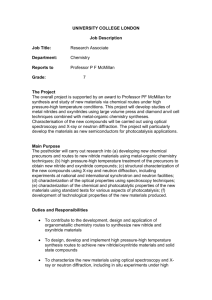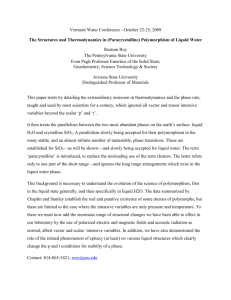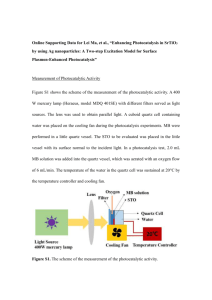INTRODUCTION - VLSI Research Group of the University of Toronto
advertisement
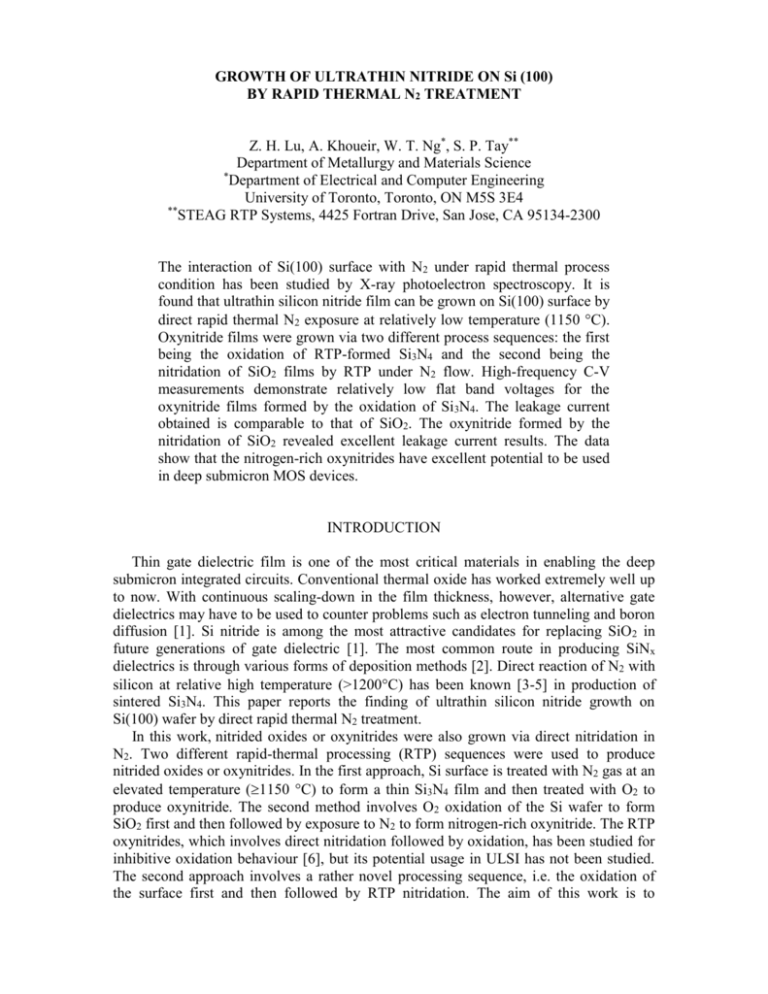
GROWTH OF ULTRATHIN NITRIDE ON Si (100) BY RAPID THERMAL N2 TREATMENT Z. H. Lu, A. Khoueir, W. T. Ng*, S. P. Tay** Department of Metallurgy and Materials Science * Department of Electrical and Computer Engineering University of Toronto, Toronto, ON M5S 3E4 ** STEAG RTP Systems, 4425 Fortran Drive, San Jose, CA 95134-2300 The interaction of Si(100) surface with N2 under rapid thermal process condition has been studied by X-ray photoelectron spectroscopy. It is found that ultrathin silicon nitride film can be grown on Si(100) surface by direct rapid thermal N2 exposure at relatively low temperature (1150 C). Oxynitride films were grown via two different process sequences: the first being the oxidation of RTP-formed Si3N4 and the second being the nitridation of SiO2 films by RTP under N2 flow. High-frequency C-V measurements demonstrate relatively low flat band voltages for the oxynitride films formed by the oxidation of Si3N4. The leakage current obtained is comparable to that of SiO2. The oxynitride formed by the nitridation of SiO2 revealed excellent leakage current results. The data show that the nitrogen-rich oxynitrides have excellent potential to be used in deep submicron MOS devices. INTRODUCTION Thin gate dielectric film is one of the most critical materials in enabling the deep submicron integrated circuits. Conventional thermal oxide has worked extremely well up to now. With continuous scaling-down in the film thickness, however, alternative gate dielectrics may have to be used to counter problems such as electron tunneling and boron diffusion [1]. Si nitride is among the most attractive candidates for replacing SiO 2 in future generations of gate dielectric [1]. The most common route in producing SiNx dielectrics is through various forms of deposition methods [2]. Direct reaction of N2 with silicon at relative high temperature (>1200C) has been known [3-5] in production of sintered Si3N4. This paper reports the finding of ultrathin silicon nitride growth on Si(100) wafer by direct rapid thermal N2 treatment. In this work, nitrided oxides or oxynitrides were also grown via direct nitridation in N2. Two different rapid-thermal processing (RTP) sequences were used to produce nitrided oxides or oxynitrides. In the first approach, Si surface is treated with N2 gas at an elevated temperature (1150 C) to form a thin Si3N4 film and then treated with O2 to produce oxynitride. The second method involves O2 oxidation of the Si wafer to form SiO2 first and then followed by exposure to N2 to form nitrogen-rich oxynitride. The RTP oxynitrides, which involves direct nitridation followed by oxidation, has been studied for inhibitive oxidation behaviour [6], but its potential usage in ULSI has not been studied. The second approach involves a rather novel processing sequence, i.e. the oxidation of the surface first and then followed by RTP nitridation. The aim of this work is to electrically characterise the ultrathin films and to explore its viability as a SiO 2 substitute for future CMOS device generations. EXPERIMENTS The nitridation was carried out in a Steag Heatpulse 410 rapid thermal processing (RTP) apparatus. Boron-doped Si(100) wafers, 100 mm in diameter, were used for the nitridation experiment. All wafers were cleaned using the RCA clean recipes and then dipped in an aqueous HF solution to remove the native surface oxide. The cleaned wafers were loaded into the RTP for nitride growth. The film thickness and chemical composition were studied by X-ray photoelectron spectroscopy (XPS). The XPS measurements were carried out in a PHI 5500 system which is equipped with a monochromatic Al K source and a hemispherical electron analyzer. As there is no accurate photoelectron mean free path value for the silicon nitride, we used parameters [7] calibrated for the SiO2 to obtain nitride thickness. MOS capacitors were fabricated on 10-25 -cm (100) p-type Si substrates that were cleaned using standard RCA clean. Five kinds of gate dielectrics were prepared according to the conditions listed in table 1. The polysilicon-gate, 300 nm thick, was deposited by LPCVD at 625 ºC with a doping concentration of ~ 1x1020/cm3. After activating the impurities, Al was sputtered and the wafers were then sintered in forming gas at 435 ºC for 25 min. The gates were defined by wet etching. For this study, we used square capacitors with an area of 3.36x10-3 cm2. The instruments used to test the capacitors include an HP 4155A Semiconductor Parameter Analyser for leakage current measurements, and an HP 4280A for high-frequency (1 MHz) C-V measurements. Table 1: Oxynitride growth conditions for MOS capacitors Physical thickness SAMPLE STEP 1 STEP 2 RNO N2, 1150 ºC, 20 s O2, 1050 ºC, 60 s 32 Å RON O2, 850 ºC, 60 s N2, 1200 ºC, 60 s 14 Å OX O2, 1020 ºC, 60 s 32 Å RESULTS AND DISCUSSIONS Growth of Ultrathin Si nitride Figure 1 shows Si 2p core level spectra recorded from the samples exposed to N2 at 1150 C for various times, as labeled. There is no indication of nitride formation at temperatures below 1150 C. As can be observed from Fig. 1 there are two doublet peaks observed on surface with a short 1 s duration at 1150 C. The doublet is caused by spinorbit splitting, p1/2 and p3/2, which have a width energy separation of 0.6 eV and an intensity ratio ½. The doublet with the p3/2 position at about 99 eV is from the bulk silicon. Based on its binding energy, the second doublet (not resolved) at about 103 eV is attributed to SiO2 [8]. The formation of such SiO2 film is attributed to surface oxidation by the residual oxygen in the RTP system during temperature ramp up. For a 10 s duration, it is found that the intensity of the SiO2 peak at about 103 eV is dramatically reduced and another doublet peak at about 101.2 eV emerged. This latter peak with a chemical shift of 2.37 eV is characteristic of Si3N4 species [9]. With a longer time N2 treatment, the nitride peak intensity increases. This indicates growth of nitride film on the silicon surface. Fig. 1. Si 2p core level spectra recorded from samples treated by N2 at 1150 C for various time, as labeled. The doublet peaks associated with SiO2, Si3N4, and bulk Si have also been labeled. Figure 2 shows N 1s core level spectra as a function of N2 exposure time at 1150 C. The intensities of the spectra were as recorded. As can be seen from the figure that there is no indication of N peak for a short 1 s exposure, confirming Si 2p data of no nitride formation. In a previous study, Green et al. [10] reported oxynitride formation by direct N2 RTP. The N detection limit of the current XPS measurement is submonolayer, comparable to nuclear reaction analysis used in ref. 10. The oxynitride formation by direct reaction with N2 was attributed to [10] catalytic reaction with residual gases such as H2O. With a longer (>1s) duration time, a stronger N 1s peak becomes visible and its spectral intensity increases with increasing N2 exposure time. The binding energy of N 1s peak is found to be at 397 eV, characteristic of Si3N4 species. This indicates that N has reacted with the surface to form nitride. The nitride formation increases with increasing N2 exposure time. Fig. 2. N 1s core level spectra recorded from samples treated by N2 at 1150 C for various times, as labeled. Figure 3 shows the nitride thickness as a function of N2 exposure time at 1150 oC. The thickness is found to saturate very quickly after 60 s exposure. This growth kinetics may be explained by a logarithmic growth model. The nitride thickness (in an unit of Å), d, as a function of exposure time (in an unit of sec), t, may be fitted to an equation, d = A log (Bt + 1) + C, where the constant A, B and C takes value of 2.6, 30, and 5, respectively. A constant of 5 Å at t=0 sec indicates the fact that nitridation starts on an oxidized surface with an equivalent (in terms of N diffusion coefficient) of 0.5 nm nitride. The inset shows the thickness as a function of nitridation temperature at a constant 60 s exposure time. The nitride thickness is found to increase linearly as a function of temperature.. 16 14 12 Nitride Thickness (A) Nitride Thickness ( A) 30 o 10 8 6 4 Fig. 3. Nitride thickness as a function of N2 exposure time. The inset shows nitride thickness as a function of temperature at a constant 60 s N2 exposure time. 25 20 15 10 5 0 1050 2 1100 1150 1200 1250 1300 o Nitridation Temperature ( C) 0 0 50 100 150 200 250 300 N2 Exposure Time (s) Now let us discuss possible mechanisms for the nitride formation. It is evident that there is a thin SiO2 formed during temperature ramp up. As soon as the temperature reaches a critical temperature ( 1150 oC), the SiO2 film starts to decompose and the nitride starts to form. This suggests a possible chemical reaction process, 2N2 + 4Si + SiO2 Si3N4 + 2SiO. This initial nitridation proceed at a very fast rate till all oxide has been converted into nitride. The nitride is well known for its ability to block the diffusion of impurities and reactants. Therefore a thin nitride film effectively block the diffusion of reactant, possibly atomic N, to the nitride/Si interface and thus prevent further nitridation. Nevertheless, the thickness of the RTP nitride fits the general requirement for the future ULSI technology. Moreover, the processing thermal budget at 1150 oC is certainly feasible. Thus the RTP N2 may provide another attractive alternate for the future gate dielectrics. Growth of Ultrathin Nitrogen-rich Oxynitride Two different RTP process sequences were used to produce N-rich oxynitrides. In the first approach, Si surface is treated with N2 gas at an elevated temperature (1150 C) to form a thin Si3N4 film, as described above. The nitride films were then treated with O2 in the RTP to produce N-rich oxynitride. The second method involves O2 oxidation of the Si wafer to form SiO2 first and then followed by exposure to N2 to form nitrogen-rich oxynitride. The growth of nitrogen rich oxynitrides is achieved by exposing SiO2 films to N2 at temperatures 1150 C. Three different SiO2 films, with thicknesses of 50, 25 and 16 Å, were thermally grown under O2 in the RTP at 1010, 910 and 850 ºC, respectively. Figure 4 shows the N content of these oxynitride films. It is observed that there is no nitrogen incorporation in the 50 Å SiO2 film. Nitrogen incorporation, however, is found on thin ( 25 Å) films when the temperature is higher than 1150 C. The nitridation of the 16 Å SiO2 film shows a different behaviour as compared with the one obtained when nitriding the 25 Å SiO2 film. The nitridation of the 16 Å SiO2 film at 1200 ºC forms a nitrogen rich oxynitride film, while a Si3N4 is formed when nitrided at 1250 ºC. This indicate that the SiO2 decompose totally upon nitridation at 1250 ºC and a new ultrathin pure nitride film is grown. The absence of nitrogen in the 50 Å SiO2 film and the disappearance of oxygen in the 16 Å film indicate that nitridation occurs at the Si-dielectric interface. As soon as the temperature reaches a critical temperature (1150 ºC), the SiO2 film starts to decompose at the SiO2/Si interface and nitride starts to form, provided that N can diffuse to the interface. N Concentration (at.%) 50 40 30 20 10 0 0 50 1150 1200 1250 Temperature °C Fig. 4 Nitrogen concentration as a function of nitridation temperature at a constant time of 60 s. () represents the nitridation of 50 Å SiO2 film, () the nitridation of 25 Å SiO2 film, and () the nitridation of 16 Å SiO2 film. XPS results indicate that the samples with an initial thickness of 50 Å SiO2 were free of nitrogen. Conversely, the N 1s spectrum for the samples with an initial SiO2 thickness of 25 and 16 Å revealed the presence of nitrogen only when nitridation took place at 1200 and 1250 C. The films nitrided at 1150 C reveal no presence of nitrogen. The N 1s binding energies for the samples with an initial SiO2 thickness of 25 Å that underwent nitridation at 1200 and 1250 C for 60 s are 397.55 and 397.52 eV [11], respectively. These values are typical of binding energies obtained for oxynitride films. The N 1s binding energies for the samples with an initial SiO2 thickness of 16 Å that underwent nitridation at 1200 and 1250 C for 60 s are 397.52 and 397.1 eV, respectively. The sample that was nitrided at 1250 C shows a relatively low binding energy; it is comparable with that of a pure silicon nitride sample. The Si 2p spectrums for the nitrided samples with initial SiO2 thicknesses of 16 Å were also obtained. The binding energies corresponding to the nitrided samples at 1150, 1200 and 1250 C, are 99.16, 99.12 and 99.12 for the Si0 peaks and 103.16, 102.92 and 101.5 for the Si+4 ones, respectively. The Si+4 peak location decreases with increasing nitridation temperature. The chemical shift for the nitrided sample at 1150 C is 4 eV, which matches that of SiO2 with a comparable thickness, thus confirming again the absence of nitrogen upon nitridation at 1150 C. The chemical shift for the nitrided sample at 1200 C is 3.8 eV, while it is 2.38 eV for that nitrided at 1250 C. A chemical shift of 2.38 eV is typical of a pure Si3N4 film [9]. This observation confirms the conclusion obtained earlier with regards to the mechanism of nitridation, which takes place at the Si/SiO2 interface. The sample nitrided at 1200 C forms an oxynitride film denoted by a chemical shift that falls between that of a pure nitride and that of SiO2. Electrical Characteristics of Nitrogen-rich Oxynitride Figure 5 shows a high frequency capacitance-voltage of various dielectric films. The SiON sample grown by the nitridation of the 16 Å SiO2 film at 1200 ºC, displays a rather “smeared out” C-V curve due to the presence of positive interface charges [12]. The accumulation of interface trapped charges is most likely the result of nitridation. The derived electrical thickness (17 Å) is relatively higher than the physical thickness (14 Å) as measured by XPS. This is expected as due to the wave nature of electrons and it has been reported that the thickness extracted from the C-V data is approximately 3-5 Å larger [7,13]. The 32 Å SiON film, grown by oxidation of nitride, shows a flatband voltage of –0.35 V, which is lower than that of the reference SiO2 (-0.75). The oxynitride shows a lower threshold voltage that makes it an attractive candidate for low power CMOS devices. The presence of nitrogen atoms in the dielectrics is proven to be an effective diffusion barrier against boron penetration in PMOS transistor [14]. Fig. 5. High-frequency capacitance-voltage characteristics of various dielectrics. The thickness shown is the electrical thickness. Figure 6 shows a current-voltage characteristics of various dielectric films. The leakage current measured from both types of oxynitride films is comparable to that obtained from a 32 Å SiO2. For the nitrogen rich ultra-thin oxynitride (17 Å), we find a tremendous improvement in leakage current thus making the film a potential candidate for sub 2 nm gate dielectrics. At 2 V, the nitrogen rich oxynitride developed by oxidation followed by nitridation exhibits a leakage current of 1.2 x 10-5 A/cm2. This value is much lower than those reported for a 24 Å NO grown oxynitride [15], a 19 Å N2O oxynitride, and a Ta2O5 gate stack with EOT of 19 Å [16]. Based on XPS measurements, we find the N content in the our current oxynitride film is at least twice more than that of the regular oxynitride films grown by RTP in an N2O ambient [9]. -3 1x10 -4 1x10 -5 1x10 -6 1x10 -7 1x10 -8 2 JG (A/cm ) 1x10 Fig. 6. Current-voltage characteristics of various dielectrics. The thickness shown is the electrical thickness. 17 Å SiON 32 Å SiO2 32 Å SiON 0 1 2 3 4 5 VG (V) CONCLUSIONS Ultrathin silicon nitride films have been formed upon running Si wafers in the RTP under N2 flow at temperatures higher than 1150 C. XPS results have demonstrated the decomposition of SiO2 formed during ramp-up and the subsequent formation of pure Si3N4.The nitrogen-rich oxynitride film grown via oxidation followed by nitridation reveals excellent leakage current results, comparable to that of high k materials. These results indicate the possibility of using conventional RTP system to produce N-rich oxynitride as gate dielectric for deep submicron MOSFET’s. ACKNOWLEDGMENT The authors acknowledge the financial support of MICRONET and Natural Sciences and Engineering Research Council of Canada (NSERC). REFERENCES 1. See, for example, L. C. Feldman, E. P. Gusev, and E. Garfunkel, ”Ultrathin dielectrics in silicon microelectronics-an overview”, in “Fundamental Aspects of Ultrathin dielectrics on Si-based Devices”, edited by E. Garfunkel, E. Gusev, and A. Vul (Kluwer Academic Publisher, Boston, 1998), p 1. 2. See, for example, “Ultrathin SiO2 and High-K Materials for ULSI Gate Dielctrics”, Mat. Res. Soc. Symp. Proc. Vol. 567 (MRS, Warrendale, 1999). 3. S. M. Hu, J. Electrochem. Soc. 113, 693 (1966). 4. A. Atkinson, A. J. Moulson, and E. W. Roberts, J. Am. Ceram. Soc. 59, 285 (1976). 5. T. Ito, S. Hijiya, T. Nozaki, H. Arakawa, M. Shinoda, and Y. Fukukawa, J. Electrochem. Soc. 125, 443 (1978). 6. C. A. Paz de Araujo, Y. P. Huang, R. Gallegos, J. Electrochem. Soc. 136, 2035 (1989). 7. Z. H. Lu, J. P. McCaffrey, B. Brar, G. D. Wilk, R. M. Wallace, L. C. Feldman, and S. P. Tay, Appl. Phys. Lett. 71, 2764 (1997). 8. F. J. Grunthaner, P. J. Grunthaner, R. P. Vasquez, B. F. Lewis, J. Maerjian, and A. Madhukar, Phys. Rev. Lett. 43, 1683 (1979). 9. Z. H. Lu, “Synchrotron and conventional photoemission studies of oxide and oxynitrides”, in, “Fundamental Aspects of Ultrathin Dielecrtics on Si-based Devices”, edited by E. Garfunkel, E. Gusev, and A. Vul (Kluwer Academic Publisher, Boston, 1998) p. 49. 10. M. L. Green, T. Sorsch, L. C. Feldman, W. L. Lennard, E. P. Gusev, E. Garfunkel, H. C. Lu and T. Gustafsson, Appl. Phys. Lett. 71, 2978 (1997). 11. A. Khoueir, Z. H. Lu, W. T. Ng, Y. Ma, J. Vac. Sci. Technol. A 18, 724 (2000). 12. See, for example, J. Singh, “Semiconductor Devices an Introduction”, (McGraw-Hill Inc,, New York, 1994) p. 421. 13. R. Rios and N. D. Arora, in IEDM Tech. Dig., 1994, p. 613. 14. H. Hwang, W. Ting, D. L. Kwong, and J. Lee, in IEDM Tech. Dig., 1990, p. 421. 15. K. Kumar, A. I. Chou, C. Lin, P. Choudhury, J. C. Lee, and J. Lowell, Appl. Phys. Lett. 70, 384 (1997). 16. Q. Lu, D. Park, A. Kalnitsky, C. Chang, C.C. Cheng, S.P. Tay, T.J. King, and C. Hu, IEEE Elect. Dev. Lett. 19, 341 (1998).

